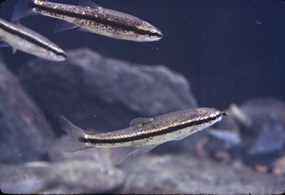 |
| Black Nosed Dace |
 |
Thirty-two species of fish have been recorded in park waters. The mountain streams of the park are one of the last completely protected strongholds of the native eastern brook trout (Salvinus fontinalis). Of the approximately 90 small streams in the park, over 50 contain brook trout. The cool forested slopes give rise to clear waters thus providing excellent habitat for this species. Other species known to occur in the park include the blacknose and longnose dace, the mottled sculpin, the bluehead chub, and the fantail darter.
Monitoring efforts by park staff have revealed interesting facts about park fish. For instance, in 1998, greenside darters were found in park waters. This was unusual because the population in Virginia was split into two distinct ranges. One is in the southwestern counties of the state and the other in the Potomac watershed. This later population is suspected to have been introduced.
One can only speculate about what influence the presence of fish had on the selection of this portion of the Blue Ridge Mountains as a national park. We know that many of the people who were influential in this selection were ardent trout anglers. President Hoover established his camp on the Rapidan River as both a retreat to ease the pressures of political life and as a location with ready access to excellent fishing. Fishing and fish observation continue to be recreational activities enjoyed by thousands today.
Related Information
A helpful reference related to freshwater fish is:
Jenkins, R.E. and N.M. Burkhead. 1994. Freshwater Fishes of Virginia. American Fisheries Society, Bethesda, Maryland.
Websites that provide photographs and helpful biological information about fish include the following:
Virginia Department of Game and Inland Fish – Virginia Fishes
EFISH: The Virtual Aquarium of Virginia’s Fish
Listing of these websites does not and is not intended to imply endorsement by the National Park Service of commercial services or products associated with the sites.
| 





